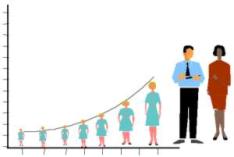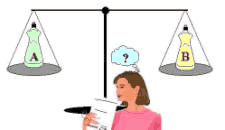![]() Receive new posting via RSS feed. >Click the icon on the left to subscribe.
Receive new posting via RSS feed. >Click the icon on the left to subscribe.
(Or right click the icon to copy and paste the link into your rss reader)
 Mind on High, Thoughts on Fast Forward and Brands on Speed.
Mind on High, Thoughts on Fast Forward and Brands on Speed.
By Max Sutherland
Ever had difficulty going to sleep because your thoughts are racing and you feel you are on a mild high? Speeding up mental processing generates some weird effects - even for ads and brands – and this has implications for fast-cut commercials.
We are often oblivious to the way our mind works because of the speed at which it operates - i.e. faster than our speed of introspection. We make sense of what we see too quickly to be conscious of the underlying processes involved, yet speeding these up can have profound effects. As brands gets recognized more rapidly, some curious things happen.
Mental Model
Consider the brand ‘Reebok’. Have you seen it before? Of course , and you recognized it almost immediately because you had a well formed mental model of it. But ask yourself this question: Why didn’t you see it as individual letters - as you did when you were first learning to read? How is it that you didn’t see it as:
R e e b o k ?
It is because having been exposed to it repeatedly, you have developed a well formed mental model of that pattern of letters. You fitted the appropriate mental model to it almost instantly and on autopilot with little effort.
With more exposures, recognition becomes even faster as something becomes highly familiar.1 Highly familiar words like ‘book’ and ‘camel’ are recognized up to three times faster than less familiar words like ‘tome’ and ‘dromedary’. Similarly, our minds process highly familiar brands more rapidly than less familiar brands.
This difference in time is only measurable in milliseconds but along with it comes another curious phenomenon. Repetition not only influences the speed of recognition but also our ‘liking’ for the brand.2 Various studies reveal that faster recognition somehow registers more positively in the brain.3 Most recently, researchers compared the brain activity triggered by short exposures to logos of familiar brands (of cars and insurance companies) with less familiar brands.4  Less familiar brands showed higher activation in working memory areas and in areas related to negative emotion. Highly familiar brands evoked a faster response that required less effort and activated areas linked with positive emotion and areas associated with self-identification and rewards. In other words, highly familiar brands seemed to be recognised more quickly, experienced more positively and were generally ‘easier on the mind’.
Less familiar brands showed higher activation in working memory areas and in areas related to negative emotion. Highly familiar brands evoked a faster response that required less effort and activated areas linked with positive emotion and areas associated with self-identification and rewards. In other words, highly familiar brands seemed to be recognised more quickly, experienced more positively and were generally ‘easier on the mind’.
Mere Exposure Effect
There is now a considerable body of research that suggests, other things being equal, the faster we recognize something and the more familiar we get with it, the more we tend to like it. This often happens as we get more familiar with a piece of music but why should it happen with a word or a brand?
This is called the ‘mere exposure’ effect and it happens not just with music and brands but with lots of other things. In the laboratory it has even been shown to happen through repetition of nonsense stuff like random dot patterns or nonsense syllables.5
You probably think this is a bit bizarre and perhaps you feel…well if that is true then why aren’t we aware of it?
First, bear in mind that this is a feather effect.6  When effects are small we really don’t notice them. Did you notice how much your child has grown today? That’s a silly question because sometimes effects like this are too small to notice. Yet you don’t doubt the reality or their cumulative impact.
When effects are small we really don’t notice them. Did you notice how much your child has grown today? That’s a silly question because sometimes effects like this are too small to notice. Yet you don’t doubt the reality or their cumulative impact.
Second, when we recognize things more quickly, it happens mostly on autopilot, so we are not aware of the subconcious ‘work’ going on in the underlying processes. This became evident a few years ago when stem cell injections restored the sight of a man who had been blind for 37 years (since the age of 3). Learning to recognize the many new things that he could now see was a slow process. Even three years later, he still had difficulty recognizing his wife’s face. He had to break her image down to less complex features such as the length of the hair and the shape of her eyebrow etc. For him, the process of integrating these bits of information into a model (for successful identification) was still on manual instead of operating on autopilot.
Practiced Skill
Admittedly it seems strange that the faster we can process something the more we like it. However, it is less strange if you think of it in this way as being like a practiced skill that becomes more accomplished with repetition and thereby takes less effort and is more rewarding.
If you think of brand identification as becoming more rapid and facilitated by practice, it helps to make sense of why product placements (i.e. brands that make paid appearances in movies and TV programs) are now so prevalent as a form of advertising. A brand’s presence in media not only conveys a perception of popularity but it also rehearses brand recognition in the brain.

If you ask ‘how does merely showing a brand in TV programs and movies persuade people to buy?’ then it is the wrong question! It doesn’t persuade people to buy but as they come to see a brand as more popular and recognize it faster, it gets marginally more attractive and ‘easier on the mind’ - which is a feather. A feather that may be enough to tip the decision to that brand, if all else is equal.
Speed Effect on Mood
If you think it seems strange that the faster we process something the more we like it, then here’s something even stranger. Faster mental processing, when it is prolonged, can also produce a carry-over effect that influences our mood.
Music that has a faster tempo puts us in a more positive mood than slower music, and new research has shown that this mood influence from pacing people’s minds, happens not just when you speed up their music but also when you speed up their thinking.7
In order to keep up with reading words passing on a screen, people were unconsciously induced to speed up their thought processing moderately above their normal speed. This turned out to have the surprising effect that it elevated their mood (as monitored not only by self report but also by electro-measurement of the face muscles that control smiling).
When people rated how they felt immediately after an exercise of accelerated reading of words, they felt more positive on a wide range of dimensions. This includes feeling more alert, attractive, important and desirable as well as an increased sense of strength, power and determination. Again, you might be skeptical and say well if that’s true why aren’t we more aware of it? Keep in mind, once again, the feather effect. This is not a huge heavyweight effect and this helps explain why it doesn’t feel obvious.
It turns out that we use feedback from our own minds on the speed of our mental processing as a circular input. It subconsciously indicates not only how much we like something but also how upbeat we feel. In other words, it feeds back on our mood.
We have long known that our mood is affected by the content of our thoughts so that when we read happy books, watch happy movies and mix with happy people, we feel happier. (Self help books use this concept to teach us how to achieve success through a positive mental attitude.) Now we know that modifying just the pace of our thinking may also affect our mood.
Conclusion
Such research suggests a number of intriguing possibilities. For one, is it possible that we can deliberately alter our own mood by simply forcing ourselves to think faster? No doubt psychology researchers will be already experimenting in a race to find a firm answer to that one.
Second, in a marketing context we may now have a more complete explanation as to why fast-cut commercials are often liked8 even though at the same time, they are often marked by poor content recall.9 The many fast cut scenes pace the viewer’s perceptions, similar to speeding up of thoughts by reading faster. In doing so, this pacing of perceptions (by fast cut scenes) may be a source not only of positive mood but also liking for the ad stimulus. Could it be that like the effect of accelerated reading the impact of mood and liking of a commercial can be induced by fast cuts, almost independent of the ad message content?10 In other words, when a commercial puts the mind on fast forward, does ‘a high’ come along with it? This represents some real food for thought for a marketing thesis topic!
Download pdf copy of "Mind on High, Thoughts on Fast Forward and Brands on Speed"
2. Winkielman P. Oct 2000. The influence of cognitive feelings on judgements and decisions. Paper presented to Association for Consumer Research Conference, Salt Lake City Utah. Oct. 2000
3. Winkielman P., Schwarz N., Reber R., and Fazendeiro T. A. (2000) Affective and Cognitive Consequences of Visual Fluency: When Seeing is Easy on the Mind. In: Visual Persuasion (ed. R. Batra), Ann-Arbor Michigan.
4. Paper “MRI shows brains respond better to name brands” presented to 2006 annual meeting of the Radiological Society of North America (RSNA) by Christine Born et al., radiologist at University Hospital, Ludwig-Maximilians University in Munich, Germany.
5. Winkielman, P., J. Halberstadt, et al. (2006). "Prototypes Are Attractive Because They Are Easy on the Mind." Psychological Science17(9): 799-806.
6. The feather effect is a term that I coined in my book to explain why we can’t introspect much on the effect of advertising. If a scale is balanced on both sides it takes only a feather added to one side to swing it. With otherwise equal brand decisions, the decisive influences are often like this. With advertising we make the mistake too often of looking for major persuasion effects rather than these, more subtle, feather effects. When we begin to look for these subtle advertising effects, a lot of what happens in advertising starts to make much more sense.
7. Pronin, E. and D. M. Wegner (2006). "Manic Thinking: Independent Effects of Thought Speed and Thought Content on Mood." Psychological Science17(9).
8. particularly but not exclusively by the young
9. McLachlan J. and Logan M. (1993) first identified this in a paper “Camera shot length in TV commercials and their memorability and persuasiveness”. Journal of Advertising Research. 33, 57-61. Rossiter et al (2001) confirmed this strong negative effect with ad shots of less than 1.5 seconds being much less likely to be recognized a week later. Rossiter J. R., Silberstein R. B., Harris P. G., and Nield G. (2001) Brain-imaging Detection of Visual Scene Encoding in Long-term Memory for TV Commercials. Journal of Advertising Research, 13-21.
10. These same fast-cut commercials often fail to leave behind much in the way of message or cognitive memory (see Franzen, G. Advertising Effectiveness. 1994 NTC Publications). Could it be that when the perceptual processing department is working flat out like this, the memory department’s lights are on, but nobody’s home?


